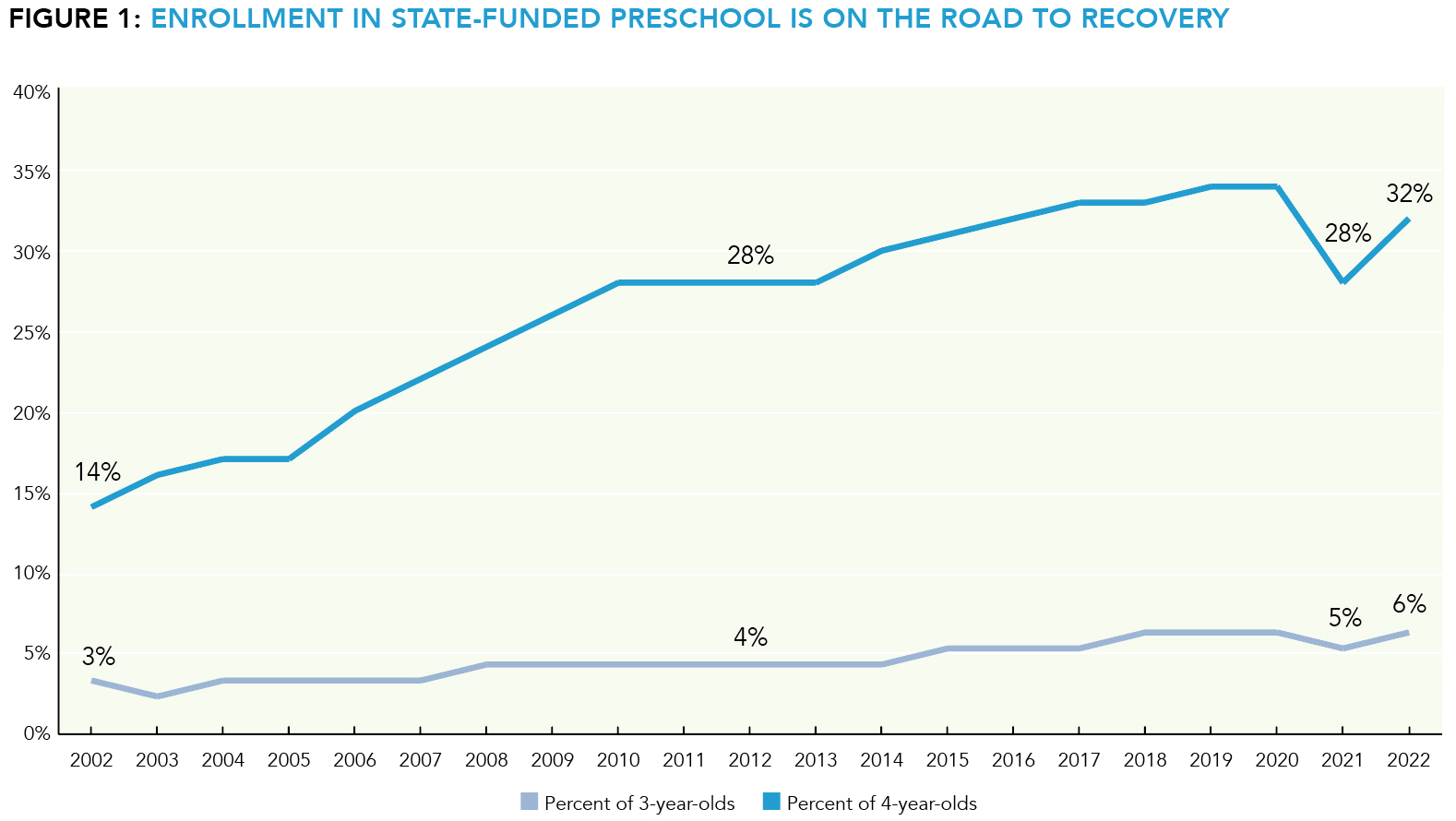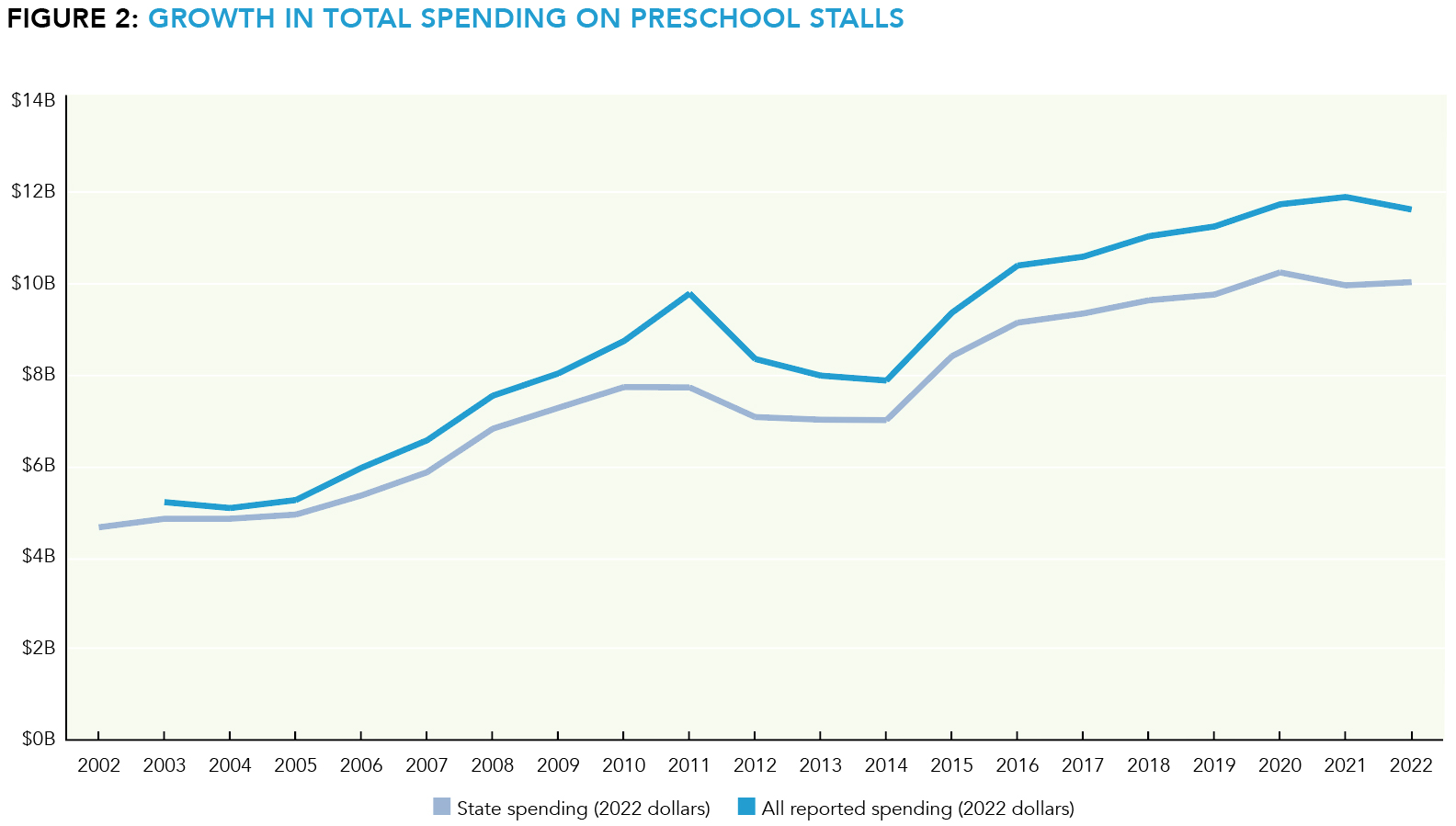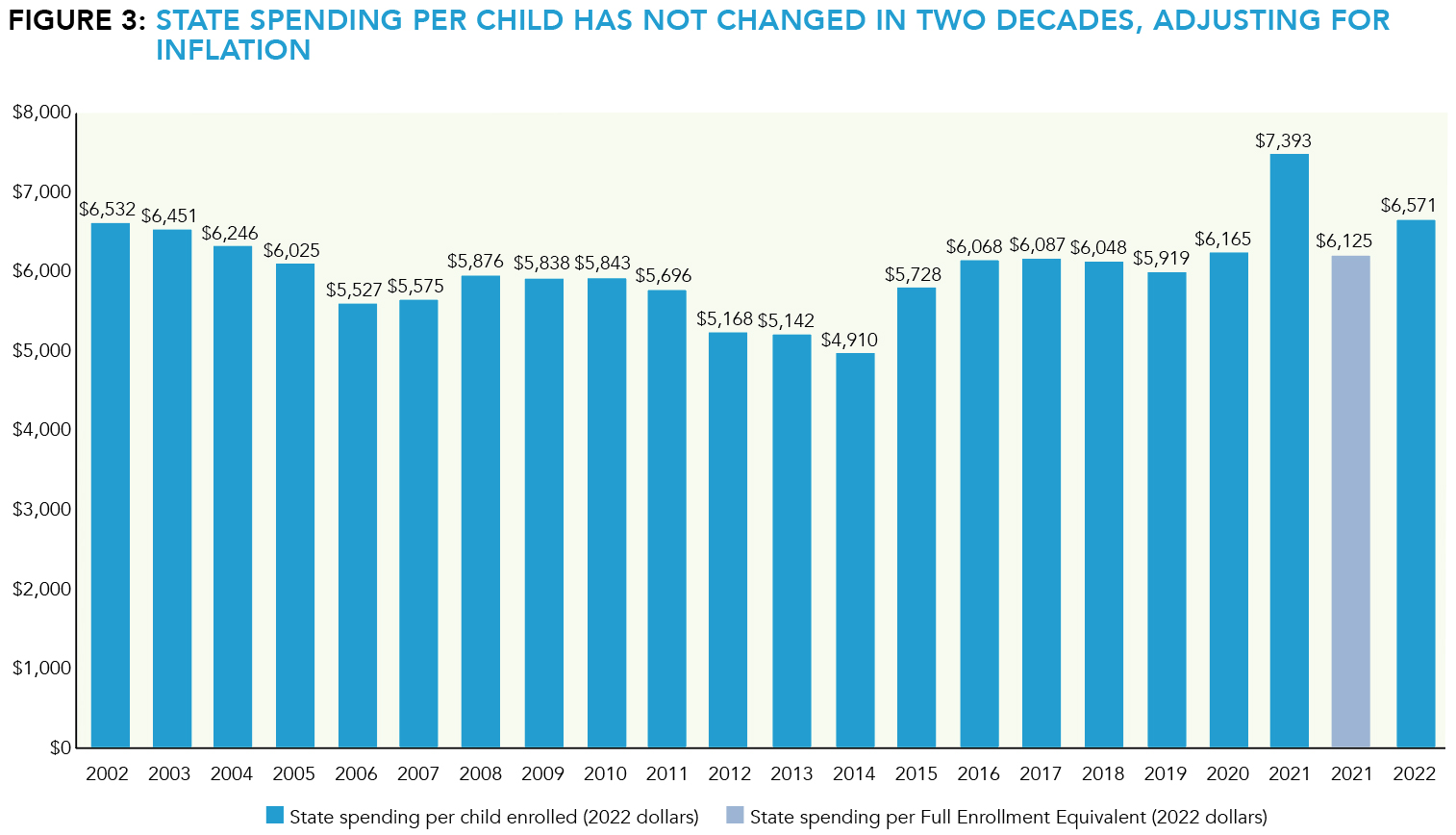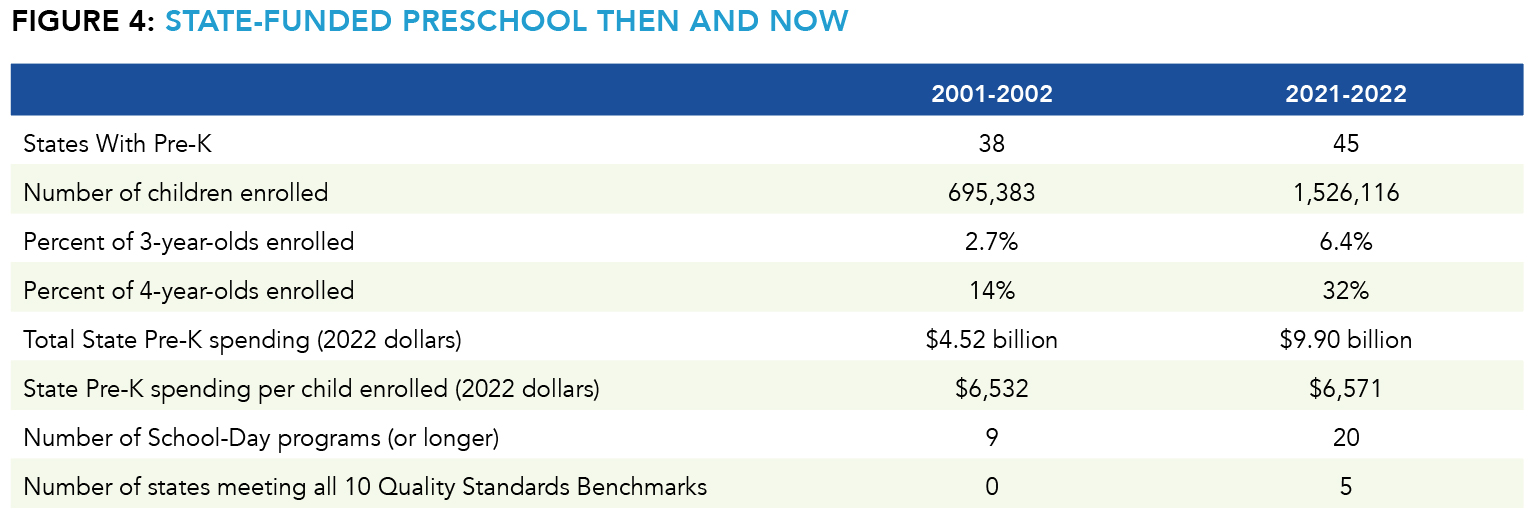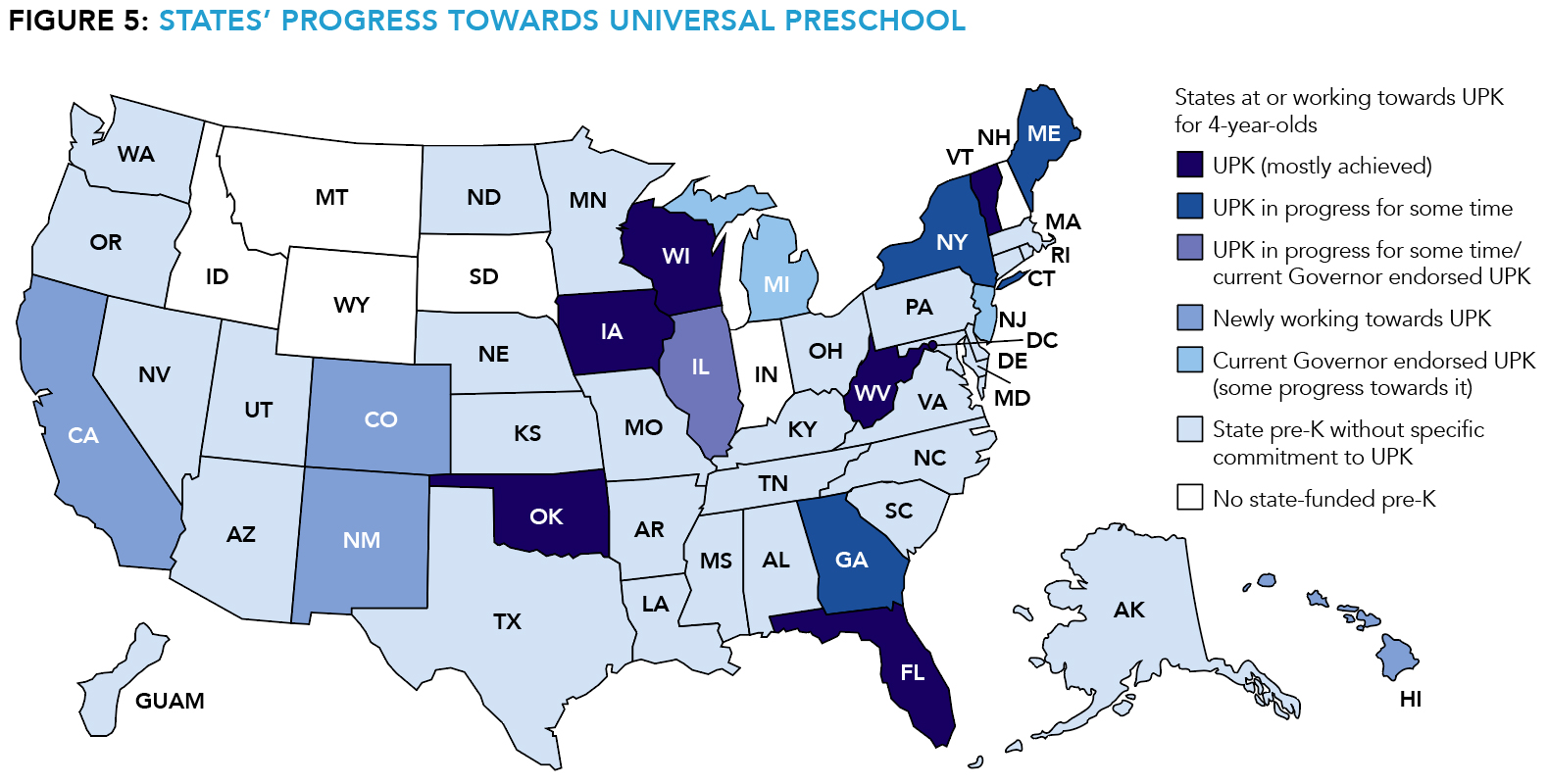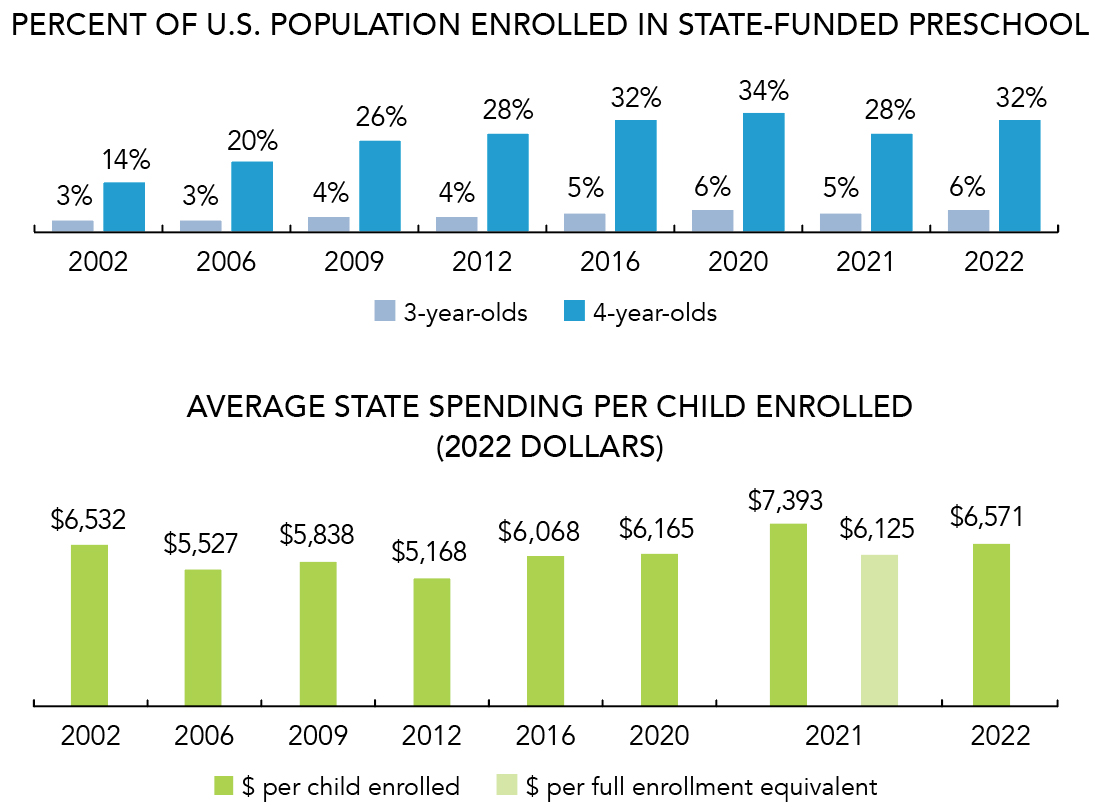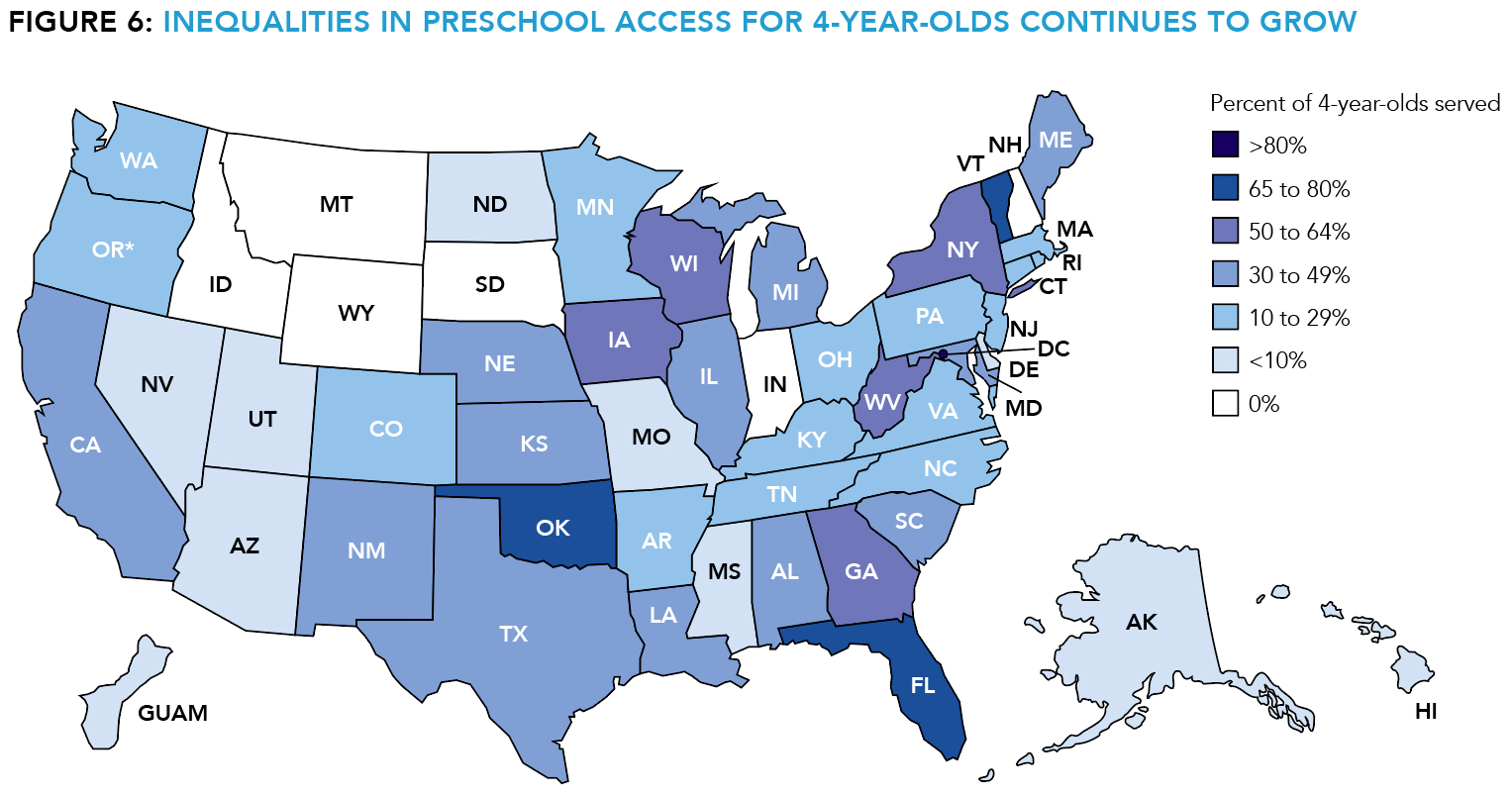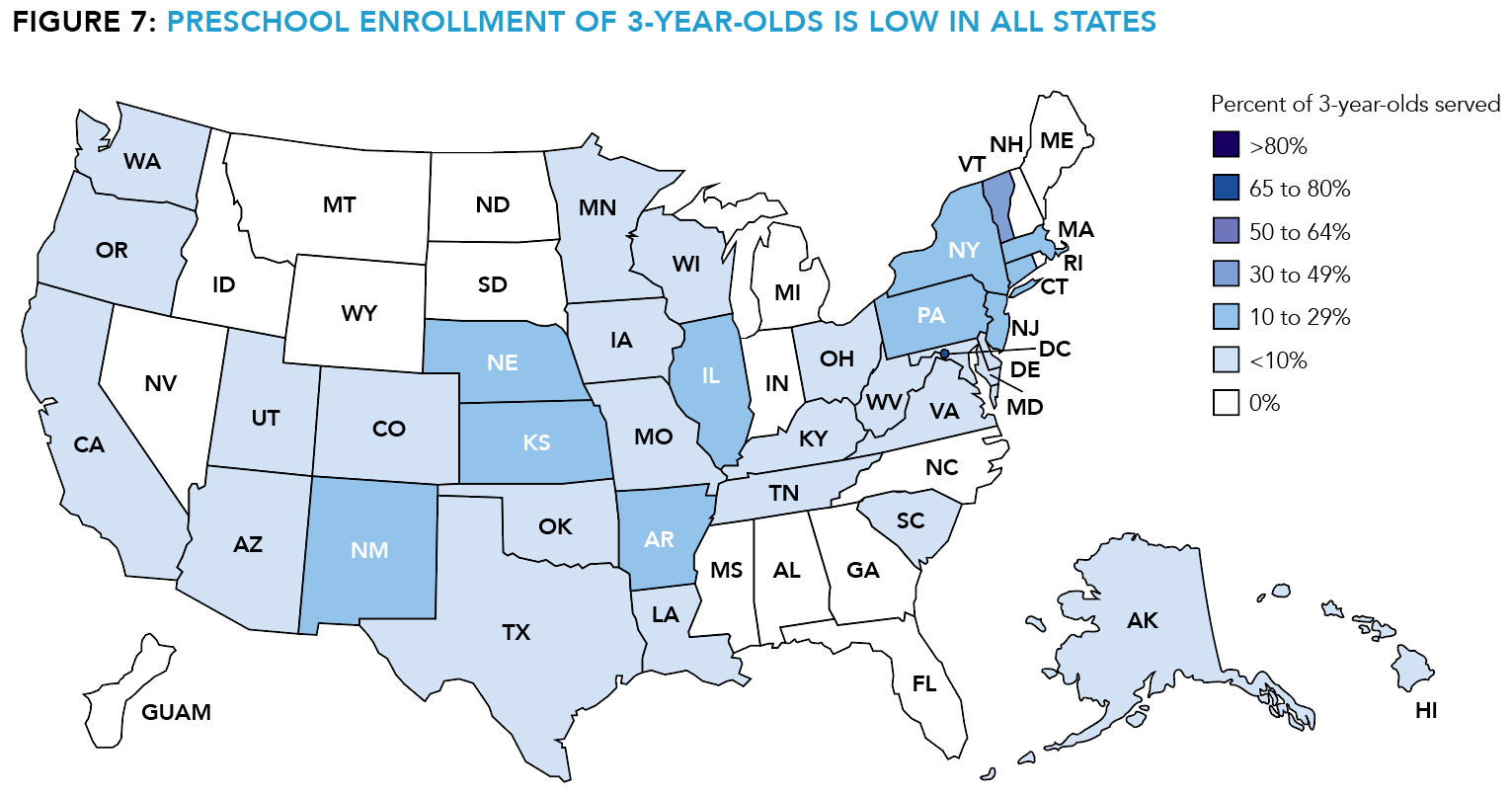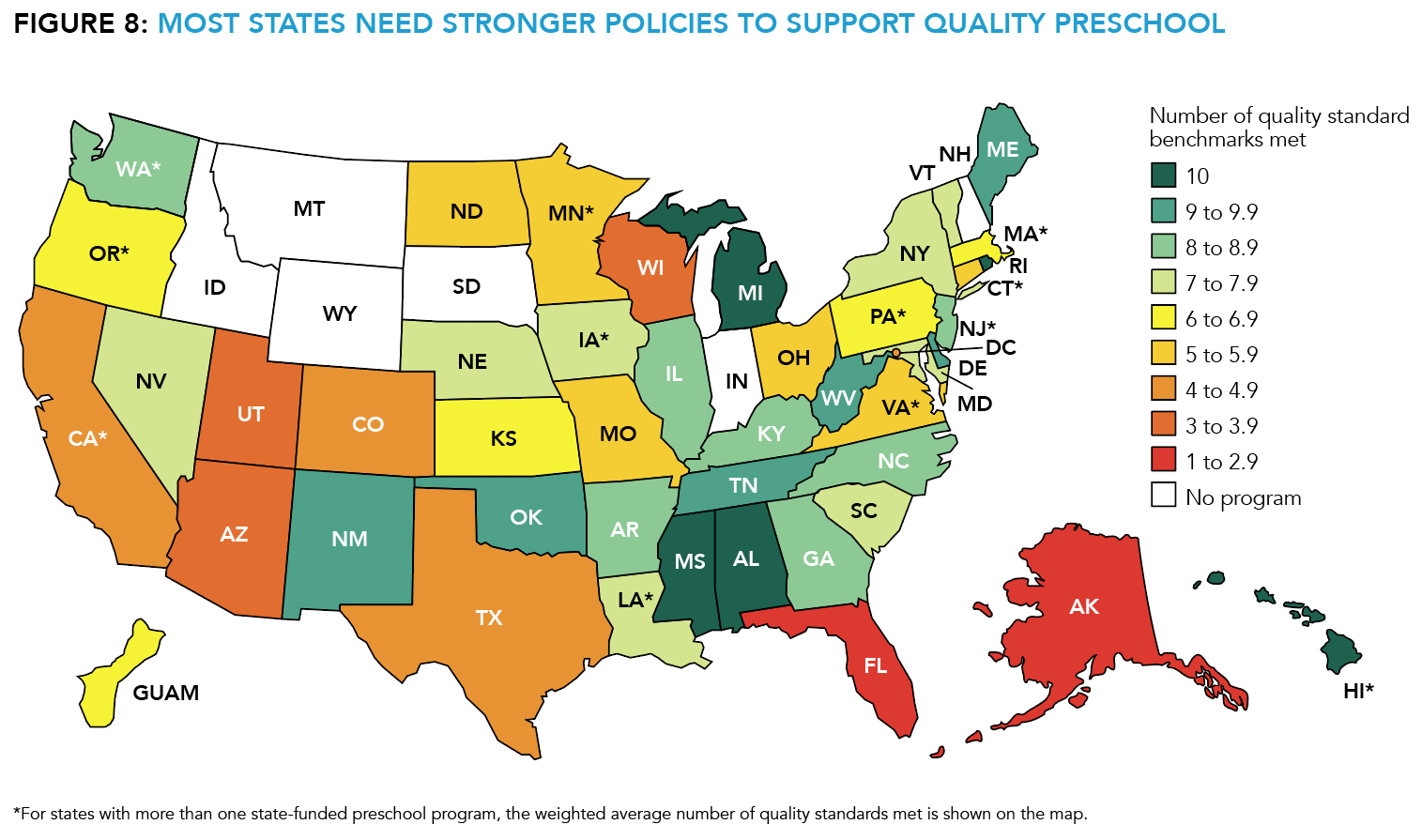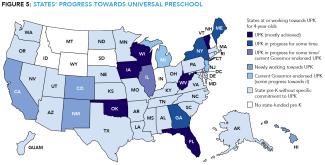
Executive Summary
The 20th State of Preschool finds reasons for both optimism and concern. After the COVID-19 pandemic erased a decade of enrollment progress in state-funded preschool, enrollment in most states is on the rebound. Several states are newly working towards universal preschool. Nevertheless, most states remain far from offering high-quality, full-day preschool to even half of 3- and 4-year-olds. This report finds uneven progress nationally and state-by-state over the past year, since the beginning of the COVID-19 pandemic, and over the past two decades.
2021-2022: A Year Of Partial Recovery
In 2021-2022, 1,526,116 children attended state-funded preschool, an increase of 180,668 children, up 13% from the 2020-2021 school year (See Figure 1). Enrollment increased in all except seven states. Most states had lifted all COVID-19 restrictions.
States spent nearly $10 billion on preschool in 2021-2022 including $9.51 billion in state funds and at least an additional $393 million in COVID-19 relief funds. This is an increase of $825 million (9%) from 2020-2021, but after-adjusting for inflation the real increase was only $71 million (0.7%, See Figure 2). Inflation-adjusted state spending increased in 22 states. The pandemic induced dip in enrollment lowered spending in a few states where funding is determined by prior year preschool enrollment rather than current enrollment. States reported using more than three times as much COVID-19 relief funding in 2021-2022 as in the prior year. All-reported spending (which includes federal, state, and local dollars) surpassed $11.5 billion, up $634 million (6%) from 2020-2021, but coming in as a $273 million (2%) decrease after adjusting for inflation. States made few changes to policies related to program quality in 2021-2022. However, some states have not yet returned to pre-pandemic implementation of policies including for continuous quality improvement. Even more widespread is that many state-funded preschool programs increased the use of waivers to teacher degree and training requirements in response to teacher shortage problems.
Not Yet Back To Normal: Change Since The Pandemic
Despite the progress made in 2021-2022, state preschool has not fully recovered from the impacts of the COVID-19 pandemic. Compared to 2019-20201, preschool enrollment was still down by 130,558 children (8%) nationally in 2021-2022 (See Figure 1). Just nine states enrolled more children in 2021-2022 than in 2019-2020; most of these states have planned expansion of preschool. State spending on preschool in 2021-2022 compared to 2019-2020 was lower by $212 million when adjusting for inflation (See Figure 2). State spending per child enrolled in preschool (including COVID-19 relief funding) was $6,571 in 2021-2022. This likely overstates the amount states would have spent per child if preschool programs had been fully enrolled in 2021-2022. Even taking this into account it is still a substantial increase compared to pre-pandemic, even after adjusting for inflation (See Figure 3). However, 64 percent of this potential increase in spending per child can be attributed to the COVID-19 relief dollars used to support state-funded preschool in 2021-2022.
Uneven Progress: Two Decades Of Change
States have made great progress expanding state-funded preschool since the first State of Preschool report on the 2001-2002 school year. Enrollment and total real spending have more than doubled with enrollment rising from 695,383 in 2001-2002 to 1,526,116 (with a high of 1,656,674 in 2019-2020 prior to the pandemic). The number of states (including DC) with at least one state funded preschool program increased from 38 to 45. Guam became the first U.S. territory to fund a preschool program. The number of programs providing full-day services to all children increased from nine to 20.
Yet, the nation has far to go to provide quality programs, and progress has been uneven. Real state spending per child is unchanged after 20 years. It remains well below what is required to fund a full-day preschool program of the quality required to meet the needs of young children for learning and development.
How much progress has been made on quality standards? In 2001-2002, no state-funded preschool program met all 10 of NIEER’s quality standards benchmarks. Today, six programs in five states meet all 10. In 2001-2002, most children in state-funded preschool attended a program meeting fewer than half of the benchmarks. Today that has decreased to 37% of children even though some of the benchmarks are now more difficult to meet. Unfortunately, that is still quite limited improvement, and higher standards in some states mean that disparities in preschool standards across the states are even greater now than 20 years ago.
Remaining Needs: What Happens Next?
Despite two decades of progress in state-funded pre-K, most children still cannot enroll in a publicly-funded early childhood education program and fewer than one in five can access a public program at age three. No doubt that is partly because states incorporated private providers into public programs rather than expanding capacity by adding new programs. However, it likely also reflects reductions in the number of 3- and 4-year-olds served by Head Start. Finally, quality matters too, and states have not increased their funding per child to support higher quality.
A look at the states with universal preschool policies provides some insights into the challenges our nation faces (See Figure 5). Six states can be said to have implemented universal preschool: Florida, Iowa, Oklahoma, Vermont, West Virginia, Wisconsin, and DC. DC is the only one to provide universal preschool at age three as well as age four. Vermont has eligibility at age three but only served 35% of 3-year-olds in 2021-2022. Most of these states have smaller populations, with only Florida in the top 20 largest states. Four other states, Georgia, Illinois, Maine, and New York have universal preschool policies on the books but have never fully implemented them. Maine is relatively new to universal preschool and expansion takes time, but the other three states have been stalled for decades.
New hope may be inspired by a new set of states that have passed laws to provide universal preschool in the past year: California, Colorado, Hawaii, and New Mexico. California is by far the most populous state and Colorado ranks 20th. If these states do not stumble out of the starting gate and offer high-quality preschool to all four-year-olds this will change the early educational opportunities of many of the nation’s young children and offer new examples for other states to follow. In two other states, the current governor has announced support for universal preschool: Michigan and New Jersey (including for 3-year-olds). Both have begun to move forward with funding to expand enrollment.
Finally, there are other states making progress enrolling more children in preschool without a legislative mandate to offer universal preschool but with an emphasis on quality. Alabama and Rhode Island are examples. These states have steadily increased enrollment of 4-year-olds in state-funded preschool with high standards, but both have a long way to go before reaching universal coverage.
Recommendations
The goal of high-quality preschool offered to every 3- and 4-year-old child is so far out of reach that every state can take action to improve on all three of the broad indicators NIEER monitors: access, quality standards, and funding. Every state could improve on access as only DC can be said to be truly universal at ages three and four. Every state could improve quality standards, with even those meeting all 10 quality standards benchmarks acting to ensure they apply to all classrooms and moving beyond the minimums needed for quality preschool. Finally, adequate funding is needed to support expansion and higher quality including salary parity for all teachers. Funding is the lynch pin. Few, if any, states provide adequate funding for a full-day, high quality program and those that come closest reach only a fraction of age-eligible children.
First, we call on every state to conduct an audit of access, quality standards, and funding adequacy for preschool education. The data provided by this Yearbook provide a starting place for that audit. Policy and advocacy leaders in each state should ask the following key questions:
- How many 3- and 4-year-old children in our state — particularly those in low-income families — lack access to publicly-funded preschool education?
- Are our state’s quality standards consistent with what we want programs to do for our young children and their families? More specifically, do standards in our state require programs to have the features of high-quality programs found to provide strong supports for children’s learning and development?
- How much additional funding is required to increase access and to enable programs to provide preschool education of the quality we want? In conjunction with this, are preschool programs funded at a level that allows them to pay lead and assistant teachers wages and benefits comparable to those in the public schools?
Second, we call on the federal government to do more to help states advance their preschool programs and to level the playing field across states by providing technical support and additional funding. We also recommend the federal government work more closely with states on policy coordination with particular attention to the role of Head Start in states with universal preschool programs. When Head Start reduces services to 3- and 4-year-olds in response to state preschool expansion this may undercut both the number of children served and quality, especially for the children Head Start serves. As this report makes clear, rarely do states serve many children at age three; programs called universal often fall far short of reaching all children, and quality can be inadequate. If Head Start is to help address these short falls, some innovation may be required.
What's New
-
- Total state spending for preschool programs reached almost $9.51 billion across 44 states and the District of Colombia*, with six states still not funding preschool in 2021-2022. States reported an additional $393 million in federal COVID-19 relief funding.
- Including COVID-19 relief dollars, there was little change in preschool funding from 2020-2021 to 2021-2022, adjusting for inflation, up just $70 million (0.7%). In nominal dollars, spending increased by $832 million (9%).
- Average state funding per child (including COVID-19 relief) was $6,571 in 2021-2022. Adjusted for inflation, this is a $406 per child increase from pre-pandemic (2019-2020). Most of the increase can be attributed to COVID-19 relief funding.
- All-reported spending, which includes local and federal dollars, to the extent states can report them, was almost $11.56 billion, an inflation-adjusted decrease of 2.3% from 2020-2021. All-reported spending per child was $7,656.
-
- States enrolled almost 1.53 million children in state-funded preschool, including almost 1.26 million 4-year-olds and 245,194 3-year-olds. States served 6% of 3-year-olds and 32% of 4-year-olds.
- Enrollment in state-funded preschool rebounded by 180,668, or 13% over 2020-2021, but enrollment was still down 8% from the pre-pandemic level of 2019-2020.
- Enrollment increased from 2020-2021 to 2021-2022 nationally and in all except seven states.
- DC and eight states enrolled more than 50% of 4-year-olds in state-funded preschool. Only DC served more than 70% of 4-year-olds (83%). Only DC enrolled more than half of 3-year-olds (69%).
- Across all the major public programs — state-funded preschool, preschool special education, and Head Start — 41% of 4-year-olds and 17% of 3-year-olds were served.
-
- Alabama, Hawaii, Michigan, Mississippi, and Rhode Island remain the only five states to meet all 10 of NIEER’s benchmarks for minimum state preschool quality standards.
- Two states gained new quality standard benchmarks as a result of policy change. Missouri completed the alignment of their ELDS with the state’s K–3 standards to meet the ELDS benchmark. Nevada began requiring health screenings and referrals and reinstituted requirements for a continuous quality improvement system, meeting two additional benchmarks.
- Eleven state-funded preschool programs met fewer than half of the quality standards benchmarks, including three of the five largest programs. Thirty-seven percent of children in state-funded preschool were in a program meeting fewer than half of the quality standards benchmarks. Only eleven percent were in a program meeting nine or ten benchmarks.
- Several programs continued to make exceptions to policies in response to the COVID-19 pandemic.
- Although NIEER continued to determine if benchmarks were met based on policy, rather than exceptions to policy, this year programs received an “*” for standards that were known to not be fully implemented. Four programs received an “*” for the lead teacher degree benchmark. Two programs received an “*” for the continuous quality improvement system benchmark.
-
- Three new programs are included in this report for the first time: Massachusetts’ Commonwealth Preschool Initiative served 841 children, North Dakota’s Best in Class served 371 children, and Virginia’s Early Childhood Foundation Mixed Delivery served 1,237.
- The Massachusetts Universal Preschool Program, the Michigan Developmental Kindergarten, the Missouri Pre-K program, and the North Dakota Early Childhood Education Grant Program are no longer included in the report.
- Most programs reported a shortage of qualified lead preschool teachers during the 2021-2022 school year. More teachers than in previous year received waivers to the education and specialized training requirements.
- Despite widespread reports of shortages, only seventeen programs reported offering incentives for recruiting or retaining teachers in state-funded preschool.
- New York greatly increased enrollment of 3-year-olds — an increase of 10 percentage points from 6% in 2020-2021 to 2021-2022.

Acknowledgements
The opinions expressed in this report are solely those of the authors. We wish to thank the Heising-Simons Foundation for supporting data collection and the development, production, and dissemination of this publication. Established in 2007 by husband and wife Mark Heising and Elizabeth (Liz) Simons, The Heising-Simons Foundation is dedicated to advancing sustainable solutions in the environment, supporting groundbreaking research in science, and enhancing the education of the nation’s youngest learners. In addition, we wish to thank the Bill and Melinda Gates Foundation for their support of the State of Preschool report. Finally, the authors would like to extend our thanks to Sandy Ogilvie for her assistance on this report.
This publication is a product of the National Institute for Early Education Research (NIEER), a unit of the Graduate School of Education at Rutgers, The State University of New Jersey. NIEER supports early childhood education policy by providing objective, nonpartisan information based on research.
